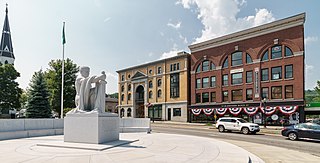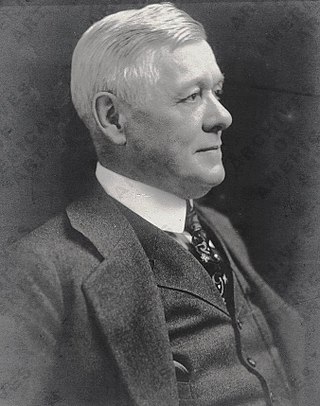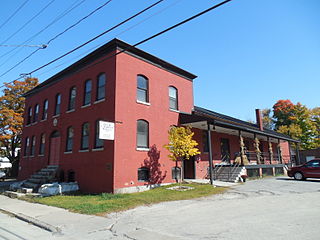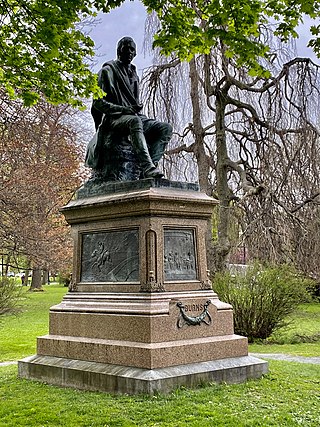
Barre is the most populous city in Washington County, Vermont, United States. As of the 2020 census, the municipal population was 8,491. Popularly referred to as "Barre City", it is almost completely surrounded by "Barre Town", which is a separate municipality.

Robert Tannahill was a Scottish poet of labouring class origin. Known as the 'Weaver Poet', he wrote poetry in English and lyrics in Scots in the wake of Robert Burns.

Alloway is a village in South Ayrshire, Scotland, located on the River Doon. It is best known as the birthplace of Robert Burns and the setting for his poem "Tam o' Shanter". Tobias Bachope, the mason responsible for the construction of Hopetoun House, Craigiehall, and Kinross House, also hailed from Alloway. Some historic parts of the village make up a conservation area.

The Alloway Auld Kirk, which dates back to the 16th Century, is a ruin in Alloway, South Ayrshire, Scotland, celebrated as the scene of the witches' dance in the poem "Tam o' Shanter" by Robert Burns.

"Tam o' Shanter" is a narrative poem written by the Scottish poet Robert Burns in 1790, while living in Dumfries. First published in 1791, at 228 lines it is one of Burns' longer poems, and employs a mixture of Scots and English.

John Massey Rhind was a Scottish-American sculptor. Among Rhind's better known works is the marble statue of Dr. Crawford W. Long located in the National Statuary Hall Collection in Washington D.C. (1926).

The Socialist Labor Party Hall at 46 Granite Street, Barre, Vermont was constructed in 1900. It was a location for debates among anarchists, socialists, and union leaders over the future direction of the labor movement in the United States in the early 20th century.

Robert Burns, also known familiarly as Rabbie Burns, was a Scottish poet and lyricist. He is widely regarded as the national poet of Scotland and is celebrated worldwide. He is the best known of the poets who have written in the Scots language, although much of his writing is in a "light Scots dialect" of English, accessible to an audience beyond Scotland. He also wrote in standard English, and in these writings his political or civil commentary is often at its bluntest.

The Robert Burns Memorial, created by sculptor George Anderson Lawson, is a monument located at Dorchester Square in Downtown Montreal.

Barre granite /ˈbæri/ is a Devonian granite pluton near the town of Barre in Washington County, Vermont. Richardson described it as a "fine granite, composed of quartz, feldspar, and mica. The mica is both muscovite and biotite." It intrudes into the Waits River Formation.

The statue of Robert Burns in Milwaukee, Wisconsin, is a work of public art by the Scottish artist William Grant Stevenson, RSA. The bronze statue, of the Scottish national poet Robert Burns, stands on a plinth of Nova Scotia pink granite with two bronze bas relief panels. The monument was donated to the City of Milwaukee by James A. Bryden.

Victoria Park is an urban park on Spring Garden Road in Halifax, Nova Scotia, Canada, across from the Halifax Public Gardens.
Frank Chalfant Gaylord II was an American sculptor best known for "The Column", a sculptural tableau of United States soldiers and sailors which is part of the Korean War Veterans Memorial in Washington, D.C.

The Spanish–American War Soldier's Monument, also known as the Spanish–American War Memorial or simply Soldiers Monument, is an outdoor sculpture and war memorial monument honoring the dead of the 2nd Oregon Volunteer Infantry Regiment of the Spanish–American War and Philippine–American War. The monument was created by American artist Douglas Tilden and located in Lownsdale Square, in the Plaza Blocks of downtown Portland, Oregon. It features a bronze statue on a marble pedestal and granite base. The monument is part of the City of Portland and Multnomah County Public Art Collection courtesy of the Regional Arts & Culture Council.

The Robert Burns World Federation is a literary society based in Kilmarnock, Ayrshire, Scotland, aimed at educating the public about the life, poetry and works of the poet Robert Burns. It is a Scottish Charity and a company limited by Guarantee. The Federation links existing Burns Clubs and similar groups, giving a unique number to affiliated Clubs, which is then used by them in their promotion and identification. Their ongoing intent is to provide a way for clubs to link together and enjoy the mutual benefit of association, communication and shared mission. It was founded in 1885

The Robert Burns Memorial is an outdoor memorial and statue of Scottish poet Robert Burns, located in Stanley Park in Vancouver, British Columbia, Canada.

The Cotter's Saturday Night is a poem by Robert Burns that was first published in Poems, Chiefly in the Scottish Dialect in 1786.

James Thom was a Scottish sculptor; his sculptures of characters from Scottish literature were immediately successful.

A statue of Robert Burns stands in Washington Park in Albany, New York, United States. The statue was designed by Charles Calverley and was unveiled in 1888. Four bas-reliefs around its pedestal, in part designed by George Henry Boughton, were later added in 1891. The statue is one of the oldest pieces of public art in the park.



















